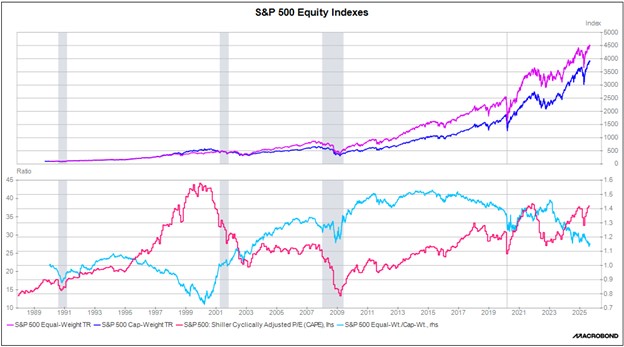by Patrick Fearon-Hernandez, CFA, and Thomas Wash
[Posted: 9:30 AM ET] | PDF
Our Comment today opens with news of a potentially fundamental change in US defense strategy that could have large implications for the country’s foreign relations, economy, and financial markets. We next review several other international and US developments with the potential to affect the financial markets today, including the latest on the search for new prime ministers in Japan and France and a sobering report on how long it may take US firms to see a positive return on their current investments in artificial intelligence.
US Defense Strategy: New reporting says the Pentagon’s draft defense strategy would prioritize domestic missions, homeland defense, and protection of the Americas region over preparing to fight major foreign rivals such as China and Russia. Although the strategy could still be revised, it appears that the current version is calling for the US to end its traditional role as the global hegemon and instead focus on being a regional hegemon, probably relying on the Pacific and Atlantic Oceans and the US nuclear arsenal to deter longer-range threats.
- The apparent strategy change is surprising because the document is being developed by Under Secretary of Defense for Policy Elbridge Colby, who has long advocated for the US to focus its military on the potential threat from China. Like other Republican China hawks, Colby has argued for shifting military resources from Europe and the Middle East to the Asia-Pacific, not to the Americas.
- If the strategy shift is finalized, a key question is what it means for future US defense spending and the economic and financial prospects of the defense industry. As we’ve noted before, isolationist sentiment in parts of the administration’s political base could force eventual defense spending cuts, even as new military technologies lead to smaller orders for major, expensive weapon systems such as aircraft carriers and bombers.
- At the same time, we think that the prospect of the US pulling back from its foreign defense commitments will continue to prompt foreign nations to hike their own spending. Some of those new orders will likely go to major US defense contractors, but the bulk will likely go to foreign defense firms.
- That validates our longstanding expectation that European and Asian defense firms could be especially well placed to enjoy increased sales, bigger profits, and higher stock prices than their US counterparts.
Japan: Yesterday, Toshimitsu Motegi, the former secretary-general of the ruling Liberal Democratic Party, became the first Japanese politician to say he will contend to replace Prime Minister Ishiba as head of the LDP and the government following his resignation on Sunday. Several other top politicians are also expected to throw their hats into the ring in the coming days, including the investor favorite, free-market advocate and former Economic Security Minister Sanae Takaichi.
China: On the sidelines of the Munich Auto Show yesterday, the executive vice-president of Chinese electric-vehicle giant BYD said about 100 of the country’s carmakers would have to be pushed out of business for the industry to stabilize. The statement comes as Beijing starts taking top-down steps to rein in the country’s growing problem with excessive industrial capacity and debilitating price wars in many industries. However, some observers believe that even putting 100 carmakers out of business would leave China with too many auto firms.
Indonesia: Following last month’s widespread protests against government corruption and lawmaker privileges, President Prabowo Subianto yesterday fired longtime Finance Minister Sri Mulyani Indrawati. The firing of the respected finance official suggests the president may be considering looser fiscal spending to curry favor with voters. Reflecting the threat to financial discipline, Indonesia’s benchmark stock index fell approximately 1.8% today, while the rupiah has weakened about 1.0% against the US dollar.
European Union: ASML, the Dutch maker of semiconductor manufacturing equipment, has announced that it will invest 1.3 billion EUR ($1.5 billion) in the French artificial intelligence start-up Mistral to help foster its “strategic technology.” As the US and China battle for the lead in AI technology and development, leaving other major countries in their dust, the ASML-Mistral deal illustrates how European countries are scrambling to catch up, or at least avoid falling into irrelevance.
France: As previewed in our Comment yesterday, Prime Minister Bayrou did lose yesterday’s no-confidence vote in parliament, with 364 of the 577 lawmakers voting against him. President Macron today will accept Bayrou’s resignation and may announce a nominee to replace him. Even so, whoever accepts the poisoned chalice to try to become the next prime minister will face the same challenges of a fractured parliament and strong resistance to economic reform, which will likely weigh on French asset values and push bond yields higher.
US Labor Force: According to the Department of Education, high schoolers’ average math and reading scores in the National Assessment of Educational Progress for 2024 fell to their lowest levels on record. The share of 12th graders rated as “proficient” or above also declined, to just 22% in math and 35% in reading. Such abysmally low levels of proficiency have long been seen as an Achilles heel for the US that will leave companies without the educated workers they need to reindustrialize and compete globally in high technology and the sciences.
US Artificial Intelligence: Julie Sweet, CEO of consulting giant Accenture, said in an interview with Axios that it will probably take several years for US companies to really see a positive return on their AI investments. According to Sweet, that’s because it will take time for firms to retrain their workforces and revamp their operations to make full use of the technology. The statement is consistent with other recent studies and commentaries that have warned that the payoff from AI may be further in the future, creating some risk of a pullback in AI-related stocks.







